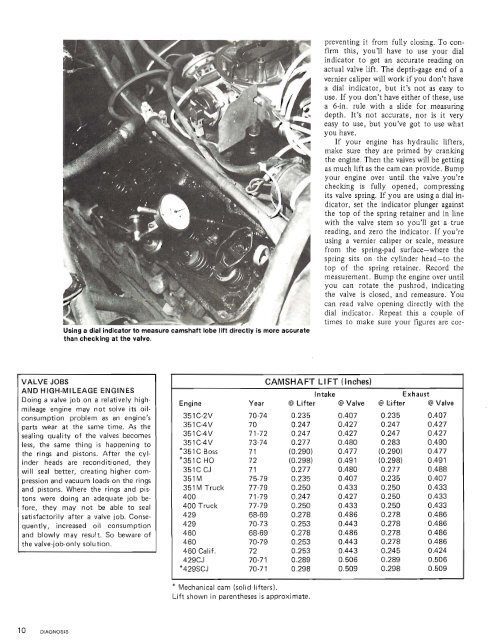How To Rebuild Your Ford V-8 351C-351M-400-429-460.pdf - Index of
How To Rebuild Your Ford V-8 351C-351M-400-429-460.pdf - Index of
How To Rebuild Your Ford V-8 351C-351M-400-429-460.pdf - Index of
Create successful ePaper yourself
Turn your PDF publications into a flip-book with our unique Google optimized e-Paper software.
10 DIAGNOSIS<br />
Using a dial indlcator to measure camshaft lobe lift dlrectly is more accurate<br />
than checklng at the valve.<br />
preventing it from fully closing. <strong>To</strong> confirm<br />
this, you'll have to use your dial<br />
indicator to get an accurate reading on<br />
actual valve lift. The depth-gage end <strong>of</strong> a<br />
vernier caliper will work if you don't have<br />
a dial indicator, but it's not as easy to<br />
use. If you don't have either <strong>of</strong> these, use<br />
a 6-in. rule with a slide for measuring<br />
depth. It's not accurate, nor is it very<br />
easy to use, but you've got to use what<br />
you have.<br />
If your engine has hydraulic lifters,<br />
make sure they are primed by cranking<br />
the engine. Then the valves will be getting<br />
as much lift as the cam can provide. Bump<br />
your engine over until the valve you're<br />
checking is fully opened, compressing<br />
its valve spring. If you are using a dial indicator,<br />
set the indicator plunger against<br />
the top <strong>of</strong> the spring retainer and in line<br />
with the valve stem so you'll get a true<br />
reading, and zero the indicator. If you're<br />
using a vernier caliper or scale, measure<br />
from the spring-pad surface-where the<br />
spring sits on the cylinder head-to the<br />
top <strong>of</strong> the spring retainer. Record the<br />
measurement. Bump the engine over until<br />
you can rotate the pushrod, indicating<br />
the valve is closed, and remeasure. You<br />
can read valve opening directly with the<br />
dial indicator. Repeat this a couple <strong>of</strong><br />
times to make sure your figures - are cor-<br />
VALVE JOBS<br />
AND HIGH-MILEAGE ENGINES<br />
Doing a valve job on a relatively highmileage<br />
engine may not solve its oilconsumption<br />
problem as an engine's<br />
parts wear at the same time. As the<br />
sealing quality <strong>of</strong> the valves becomes<br />
less, the same thing is happening to<br />
the rings and pistons. After the cylinder<br />
heads are reconditioned, they<br />
will seal better, creating higher compression<br />
and vacuum loads on the rings<br />
and pistons. Where the rings and pistons<br />
were doing an adequate job before,<br />
they may not be able to seal<br />
satisfactorily after a valve job. Consequently,<br />
increased oil consumption<br />
and blowly may result. So beware <strong>of</strong><br />
the valve-job-only solution.<br />
CAMSHAFT LIFT [Inches)<br />
Intake<br />
Exhaust<br />
Engine Year @ Lifter @ Valve c@ Lifter @ Valve<br />
351 C-2V 70-74 0.235 0.407 0.235 0.407<br />
351 C-4V 70 0.247 0.427 0.247 0.427<br />
<strong>351C</strong>-4V 71-72 0.247 0.427 0.247 0.427<br />
351 C-4V 73-74 0.277 0.480 0.283 0.490<br />
"351 C Boss 71 (0.290) 0.477 (0.290) 0.477<br />
"351 C HO 72 (0.298) 0.491 (0.298) 0.491<br />
<strong>351C</strong> CJ 71 0.277 0.480 0.277 0.488<br />
351 M 75-79 0.235 0.407 0.235 0.407<br />
351 M Truck 77-79 0.250 0.433 0.250 0.433<br />
<strong>400</strong> 71-79 0.247 0.427 0.250 0.433<br />
<strong>400</strong> Truck 77-79 0.250 0.433 0.250 0.433<br />
<strong>429</strong> 68-69 0.278 0.486 0.278 0.486<br />
<strong>429</strong> 70-73 0.253 0.443 0.278 0.486<br />
460 68-69 0.278 0.486 0.278 0.486<br />
460 70-79 0.253 0.443 0.278 0.486<br />
460 Calif. 72 0.253 0.443 0.245 0.424<br />
<strong>429</strong>CJ 70-71 0.289 0.506 0.289 0.506<br />
"<strong>429</strong>SCJ 70-71 0.298 0.509 0.298 0.509<br />
* Mechanical cam (solid lifters).<br />
Lift shown in parentheses is approximate.
















